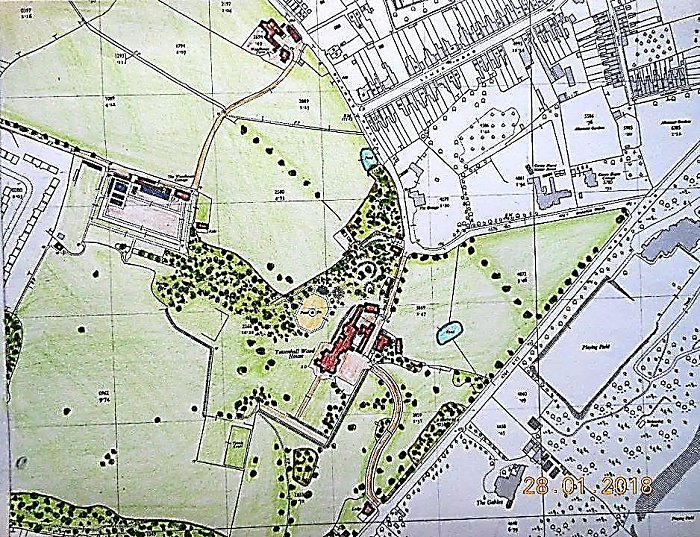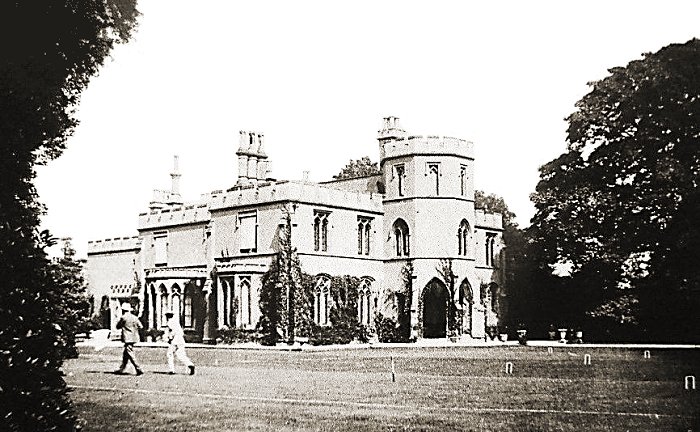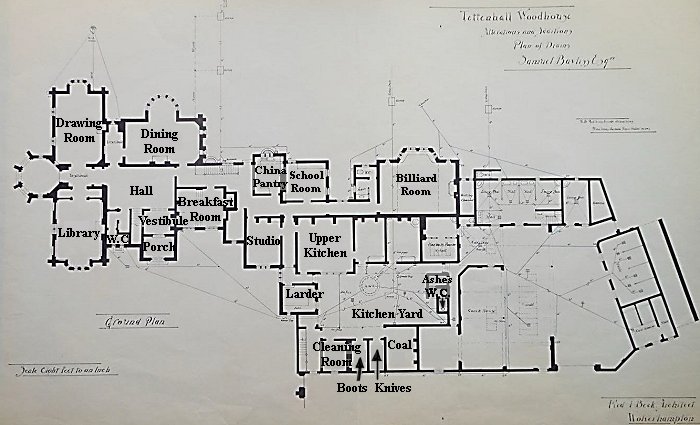|
The
Hinckes Family

Site Plan. The area of the
rectangle is approximately 90 acres.
The Wood House, built between 1833
and 1836, appears to have occupied part of the building
plot of the earlier house, which might suggest that some
of the older structure was incorporated into the newer
one, most likely the cellars only but this is not
evident from available plans. The age and appearance of
the earlier house are not known but its outline and some
garden detail can be seen on the Tettenhall Wood Common
enclosure survey of 1809 (see in the biographical
details section).
It was this earlier house that was
purchased by Peter Titchbourne Hinckes, at some time
before his death in1781 (he also owned Bushbury Hall and
was a member of the well-known Wolverhampton family of
that name). On his death he bequeathed the house and
land to his nephew Peter Tichbourne Hinckes 1753-1822
who in turn left it to his nephew and namesake Peter
Tichbourne Hinckes son of the Rev’d. Josiah Hinckes
Tragically his nephew died only
eight days after his uncle and followed him into the
same grave at Bushbury church: the estate then
automatically passed to the nephew’s father Josiah
Hinckes, brother of the legator. It was at this point it
must have become evident that the house would eventually
pass to the older of Josiah’s two daughters, Theodosia
Hinckes. Hereto Theodosia, a spinster, would have
expected to lead a very quiet life, probably caring for
her parents in their old age and eventually retiring to
a small property, possibly in Surrey where her father
had his parish: but now her prospects were considerably
enhanced and she obviously intended to make the most of
them.
Following her father’s death in
1830 and subsequently her mother’s in 1832, Theodosia
began to realise the plans that she must have been
formulating prior to their deaths, and she may have been
responsible for some of the land acquisitions mentioned
above. It begins to become evident that Theodosia was a
cultured lady with some artistic talent; informed
architectural appreciation; considerable determination
and obviously substantial funds. First she demolished
the old house and then with the additional land,
assembled her new estate.

Entrance Front: photograph: early
20th.Century?
Her proposals give the impression
that she intended to create a small model,
self-sufficient country estate on the edge of Tettenhall
village complete with the usual country estate
components, including a small home farm; walled gardens;
greenhouses; estate lodge; tree belts; rides etc. It is
difficult for us at this distance in time from the
event, to realise how innovatory this would have been in
the Tettenhall area.
Theodosia was also a moderately
accomplished amateur water colourist who, with her sister
Rebecca, ten years her junior, spent considerable time
painting watercolours of local churches that are now in
the Lichfield Cathedral Library. These confirm her
interest in and appreciation of mediaeval Gothic
architecture and in turn the Gothic Revival style.
Gothic Revival of course was not a new style, having
first appeared about eighty years before Theodosia
thought about building her house, but it had only
recently undergone a significant renaissance and rationalisation as
a result of the work of the architect Thomas Rickman.
Rickman had unlocked the secrets of the development of
mediaeval Gothic architecture and his subsequent book,
‘An Attempt To Discriminate The Styles Of Architecture
In England From The Conquest To The Reformation’
published in 1817, proved to be a very popular
publication and became the ‘Architect’s Bible’ for the
rest of the nineteenth century, going through seven
editions.
Any architect not owning a copy of
Rickman’s book, ran the risk of his buildings looking
untutored in the eyes of informed architectural
practitioners and critics. The book was also popular
with the educated public, so it is quite likely that
Theodosia owned a copy.
When she decided to build her new
house it would have been natural for Theodosia to opt
for Gothic Revival, rather than the also recently
introduced ‘Italianate’ and ‘Greek Revival’ Styles used
by Colonel Thorneycroft twenty years later when building
his house, Tettenhall Towers, on the other side of Wood
Road. She wanted the most experienced architect
available, who would work in this new refined gothic and
make it as authentic as possible, so it is no surprise
that she approached Thomas Rickman himself - she was not
going to use any second-best practitioner. By this time
Rickman had one of the busiest practices in the country
and had moved his main office from Liverpool to
Birmingham, so he was ideally placed to act for her. She
began talking to him in 1832, the year of her mother’s
death and commenced building the following year, but
neither of them could have foreseen the fraught
relationship that would arise before the building was
completed: a very busy architect with a wealthy but hard
headed business woman for a client.

Rear of house with croquet lawn,
circa 1930s.
Having identified and named four
consecutive style developments within the historical
progress of Gothic architecture, Rickman generally
favoured his third one – ‘English Decorated: 1300-1380’
- that he used for most of his Gothic Revival buildings:
so it would have been consistent for him to use this
style for Theodosia’s new house. Not only a new style
but an asymmetrical design to boot: ‘symmetry’ had held
sway for the previous 350 years but ‘asymmetry’,
probably seen as somewhat quirky, had slowly become
acceptable as being suitable for the new gothic fashion,
following its introduction in the 1750’s. Without doubt
Theodosia was going to build a showpiece unlike anything
else that had been erected in the immediate West
Midlands area up to that date. Her house would be the
first of the range of large new houses that would
eventually define Tettenhall as the area of choice for
the wealthiest industrialists in the region; not that
Theodosia would have wished to be known as an
industrialist: the 1851 census return describes her as a
‘Landed Proprietor’. Theodosia’s relatives had been
resident in Tettenhall for some years before the later
‘newcomers’ began to arrive on this elevated sandstone
escarpment to avoid the smoke their factories were
creating in and around Wolverhampton, to the east.
The new house was built between
1833 -36 and about this time Thomas Rickman was also
involved in many other projects including the New Court
of St. John’s College, Cambridge with its famous ‘Bridge
of Sighs’ (whose window tracery resembled some of that
at Tettenhall); repairs to Canterbury; Blackburn and
Worcester Cathedrals and numerous churches and houses
from the south of England up to Scotland. He had
tremendous capacity for work, including travelling
widely to supervise the work on site, but he also relied
quite heavily on his partner Henry Hutchinson.
Hutchinson caught tuberculosis and died in November 1831
placing additional strain on Rickman: consequently after
a few years his robust health also began to fade.
Matters came to a head whilst he was building Tettenhall
Wood House and he began to suffer several seizures and
falls during his travels, which led to problems when the
cost of the house escalated well beyond its fixed budget
price. Up to this point Rickman had earned a reputation
for keeping his buildings well within budget, aided by
his early financial expertise. Theodosia blamed him for
the cost overrun and refused to pay him, even taking a
legal option on his home in Birmingham, which he was
forced to sell to meet his financial obligations, when
he retired through ill health in 1838. He died three
years later in 1841 in straightened financial
circumstances: a sad end for a man who had done so much
for the quality of early 19th.century architecture and
for the enlightenment of his architectural colleagues.
Thomas Rickman’s diaries in the
RIBA Library provide some tantalising entries relating
to Tettenhall Wood House. On the 24th.January 1833 he
‘sent off the estimate of cost to Miss Hinckes which I
fear will frighten her’. On the 20th.February he meets
Theodosia hoping to finalise the plans. On the
23rd.February he mentions that he has made many designs
for Miss Hinckes and on the 4th.March he does more
sketches for her: she appears to be making many
alterations to the plans, but on the 29th.March she
decides not to alter the drawings again. It is notable
that at many of their meetings Rebecca Hinckes and her
husband are also present.

Ground Floor Plan.
Rickman refers to visiting a
brickyard in Wolverhampton on 2nd.April 1833 but the
bricks for the house may have been fired on site, a
quite common procedure at the time if suitable clay
deposits were present (see below). The stonework with
which the whole building was faced was something of a
mystery: the external walls used a hard fine grained
sandstone from an unknown source, but the carved
stonework for the window and door frames and other
details, used a fine grained oolitic limestone that
would be easier to carve than the sandstone. It is most
likely that it came from the quarries at Bath and would
have been conveyed by water, the only practical method
until the advent of the railways: in this instance it
would almost certainly have been via the Avon and Severn
rivers to Stourport and then by the Staffordshire and
Worcestershire Canal to Compton or Newbridge,
Tettenhall. Carrying building stone for long distances
by water was an ancient and tested practice but it is
likely the stone was carved near the quarry at Bath. On
the 14th May 1833 Rickman records ‘some good stone is
come’ but he doesn’t say from where. It is recorded that
he also intended to use Bath stone for a house at Lough
Fea in Ireland in the 1820’s.
The diaries also refer to the
possible re-use of materials from the house that was
being demolished, mainly timber. On the 2nd January 1834
he records making a greenhouse design for Tettenhall.
Unfortunately, the diaries stop in April 1834 when
Rickman had a catastrophic attack of liver disease, so
we have virtually nothing written about the later
construction of the house or the nature of the problems
causing the rift in relationships.
Besides the house itself Theodosia
had two more architectural ‘treats’ to beguile us. The
first was her lodge in Wood Road and the second was her
grand staircase window.
|